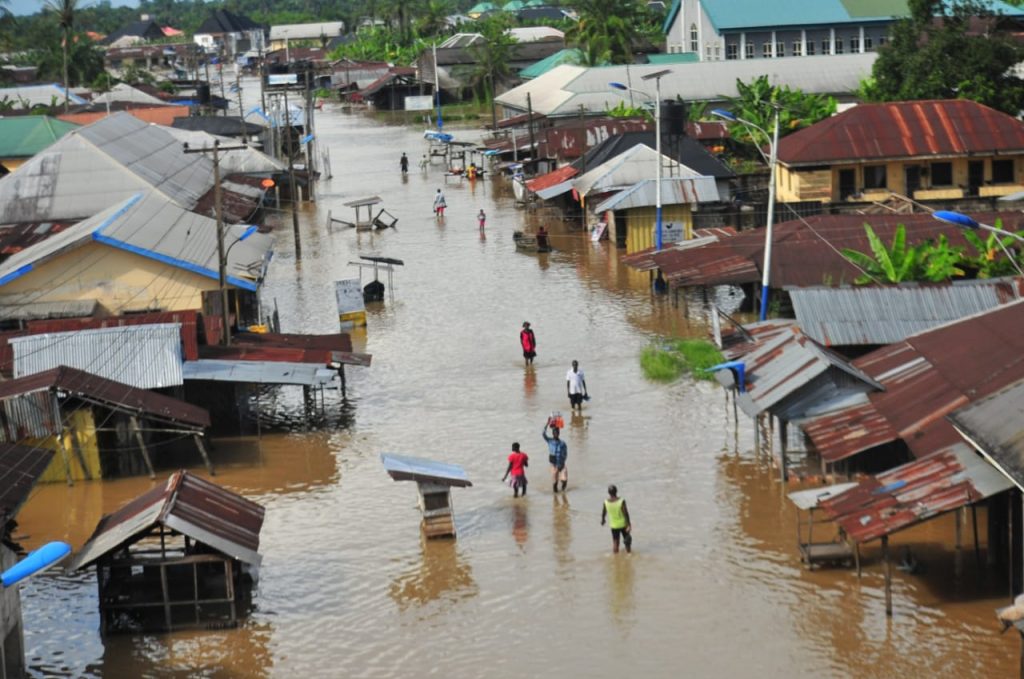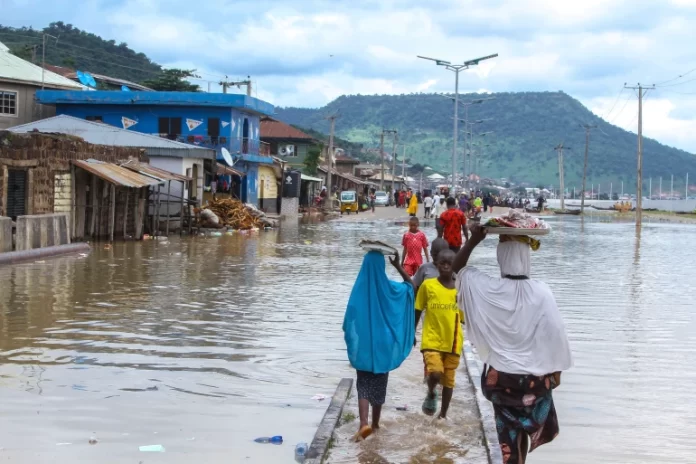Since the beginning of June 2022, flood-prone areas are on the rise, and lots of rain are being noted over local areas, in the southern part of Nigeria.
The amount of rain in total has exceeded 100MM every day. Also, floods have been recorded in some parts of the areas at risk or prone to flood. Currently, more flash floods are recorded.

The Nigerian Hydrological Services Agency (NIHSA) in their annual flood outlook, predicted 233 local government flood-prone areas in 32 states of the country.
The federal capital territory (Abuja) is included on this list. The remaining 329 local government areas are part of the flood-prone areas at risk.
READ ALSO:
States Prone to High-Risk Flooding
The states with a high risk of flood-prone areas are Taraba, Cross River, Benue, Bayelsa, Bauchi, Anambra, Akwa Ibom, Abia, Adamawa, Ekiti, Delta, Ebonyi, Jigawa, Imo, Gombe, Edo, and Kaduna.
Other states are, kogi, kebbi, Kano, Niger, Nasarawa, Lagos, Kwara, Oyo, Osun, Ondo, Ogun, Sokoto, Rivers, including FCT, and Zamfara.
The Risk
Actually, more than 2000mm of rainfall has been predicted in the southern part of Nigeria, and 390mm in the northern parts.
This trend follows what happened in the previous year, which led to flooding affecting almost 20 states. More than 10,000 households were affected in different ways.
Certainly, in the previous decade, there has been a noted form in Nigeria, especially during the past three years.
Flood is turning out to be one of the most recurrent dangers, plaguing the country after the pandemic.
However, NIMET (Nigerian Meteorological Agency) advised that adaptive, mitigative, and response mechanisms should be strengthened.
The excess flooding that is generally on record between august to October, is usually portrayed by the collapse of major dams.
In addition, the rainy season also comes with landslides, whereby hills and high land collapse and consequently burying people’s homes. The threat of erosion also has a hand in the relapse of the people and environment.
Increase in Flood
Moreover, the amount of flooding is being intensified by climate change, across the country and mainly around border sea and river states.
In urban areas, the disgust of floods has escalated, due to how development is on the rise including the poor state of waste management. This leads to poor drainage in some local areas of the country.
This situation is not limited only to the residents, as farmland and other properties can also be swept away by flood water or just submerge completely into the flood water.
Farmland has been washed away, and indecencies of livestock being washed away by flood is also a common sight when the flood comes around.
See Also: Bayelsa Farmer Cries Out After Losing Poultry to Massive Flood (video)
1n 2019 and 2020, cases of flooding were rampant in the month of October, while cases of flooding were also reported in September of 2021.
This means that climate change is causing flooding in communities that are weak earlier than usually expected.
Already, a trend that has been on the rise has been the number of people affected by flooding, which was recorded in the past four years. I expect these numbers to be on the rise In the future in Nigeria.
READ ALSO:
- Phone Call Hazards
- Muyiwa Ademola Biography
- Quality Spas in Lagos
- Doctor’s Guide to Managing Diabetes
According to the reports on world disasters in 2020, it is almost certain that severe rainfall events will happen frequently in the coming years.
These events have been predicted to happen especially, in the wet regions of the world, including Nigeria.
In addition, it was indicated by the IPCC (Intergovernmental Panel on Climate Change), that if global warming continues to increase, it could result in a wider part of the entire population being affected by floods from major rivers (IPCC, 2014b).
The probability that the coastline environment and areas that are low, will experience a lot of coastline flooding events.
The report of incidents from the states mentioned above already shows the damage flood can cause in some of these states.
People have lost their homes, properties, and farmland. Some have even lost their means of livelihood, and it is a big call for concern.
As part of the lesson learned from various flood responses, these happenings displayed that there is a need to prepare for the dangers of flooding.
Therefore, there is a need to contribute early, to help the areas at risk. This helps reduce their exposure to flooding during the rainy season.
Human Action
With everything that has been said, there is a potential for human actions to bring about consequences.
Those consequences will require steps to be taken by the concerned parties such as Red Cross, and Red Crescent Movement.
They need to take action before the peak of the rainy season when everything would get out of control.
As such, the Red Cross will take measures to combat the situation and prepare for the impact that is expected.
The preparation is important because it could limit the damaging effect the floods could have on humanity and its environment.
See Also: why-does-my-community-flood-more-than-it-used-to
Already, no fewer than 18 states have been hit by this yearly flooding. The situation got worse by poor preparation from the people, and the necessary authorities in charge despite all the warnings.
With nothing less than 300 lives lost every year across the states. Fears are beginning to grow that heavy rains have been forecasted for the months of September, October, and November.
The Dams and Canals
Findings showed that apart from the public being informed, firm measures were not taken to combat flooding.
Several states were discovered to have defaulted in ensuring that avoidable floods do not eventually happen.
Heavy Rain
In August, NEMA said that 32 states in the country and 233 LGAs were flood-prone areas in these months.
Mr. Mustapha Ahmed, the director general of the agency spoke at a workshop on the preparations for the flood.
He said that they sent letters containing advice and maps, on the areas at risk of flooding in different states.
READ ALSO: “The Rate at Which Nigerians Are Leaving the Country is Troubling” – NIS Commander Joachim Olumba
Flood risk
The minister for water resources said that a total of 8 states will experience tidal surges, sea will rise. The states mentioned include Rivers, Bayelsa, Cross River, Delta, Edo, Lagos, Ogun, and Ondo.
For more interesting articles, visit Battabox.com





